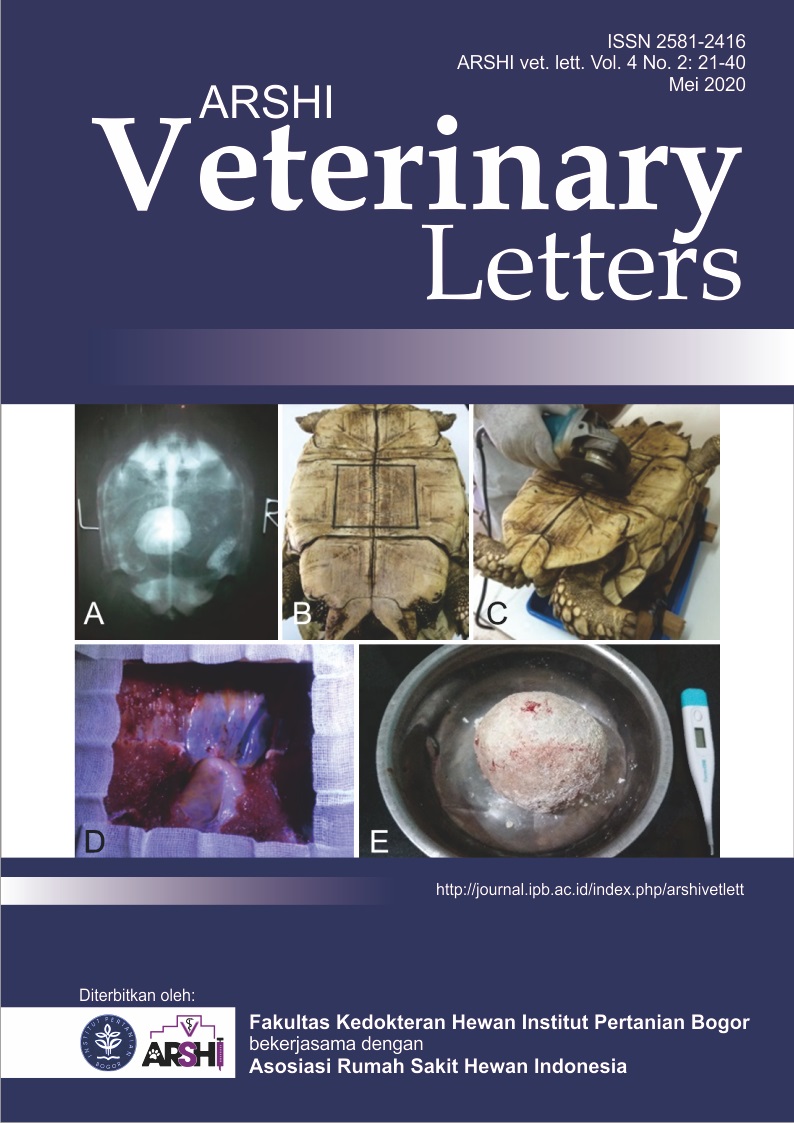Uji resistensi Escherichia coli dari peternakan ayam ras petelur di Desa Rumpin Kabupaten Bogor terhadap antibiotik
Abstract
Escherichia coli is a type of flora that very common lives in human and animals intestines. Antibiotics can be used as therapy for infection of E. coli. The unwise used of antibiotics will cause resistance. The purpose of this study was to measure resistance level of E. coli which is isolated from laying hens towards cefpodoxime cefoxitin, ceftizoxime, aztreonam, oxacillin, nitrofurantoin, and sulfamethoxazole−trimethoprim. Samples were taken from swab cloaca of laying hens. Testing of resistance level of E. coli towards antibiotics was conducted with an agar diffusion method. The obtained results would be compared with Clinical and Laboratory Standards Institute. The results showed that all of 17 E. coli isolates were resistant to cefpodoxime (100.0%), cefoxitin (58.82%), ceftizoxime (100.0%), aztreonam (94.12%), oxacillin (100.0%), nitrofurantoin (58.82%), and sulfamethoxazole−trimethoprim (82.35%).
Downloads
References
Ariyani N, Nurhidayah, Istianingsih, Ambarwati, Sari RA. 2018. Doxycycline and ciprofloxacin resistance in Escherichia coli isolated from layer feces. Di dalam: Musyawarah Nasional ke III Asosiasi Farmakologi dan Farmasi Veteriner Indonesia; 2017 Okt 7−8; Surabaya, Indonesia. Surabaya
Carattoli A. 2008. Animal reservoirs for extended spectrum β-lactamase producers. Clinical Microbiology and Infection. 14(1): 117-123.
[CLSI] Clinical and Laboratory Standards Institute. 2018. Performance Standards for Antimicrobial Susceptibility Testing. 28th Ed. Wayne (US): Clinical and Laboratory Standards Institute.
Krisnaningsih MMF, Asmara W, Wibowo MH. 2005. Uji sensitivitas isolat Escherichia coli patogen pada ayam terhadap beberapa jenis antibiotik. Jurnal Sain Veteriner. 23(1):13-18.
Magiorakos AP, Srinivasan A, Carey RB, Carmeli Y, Falagas ME, Giske CG, Harbarth S, Hindler JF, Kahlmeter G, Olsson-Liljequist B, Paterson DL, Rice LB, Stelling J, Struelens MJ, Vatopoulos A, Weber JT, Monnet DL. 2012. Multidrug-resistant, extensively drug-resistant and pandrug-resistant bacteria: an international expert proposal for interim standard definitions for acquired resistance. Clinical Microbiology and Infection. 18(3):268–281.
Markey B, Leonard F, Archambault M, Cullinane A, Maguire D. 2013. Clinical Veterinary Microbiology. 2nd Ed. London (UK): Mosby Elsevier.
Miles TD, McLaughlin W, Brown PD. 2006. Antimicrobial resistance of Escherichia coli isolates from broiler chickens and humans. BMC Veterinary Research. 2(7):1-9.
Mycek MJ, Harvey RA, Champe PC. 2001. Farmakologi Ulasan Bergambar. Ed ke-2. Hartanto H, editor. Jakarta (ID): Widya Medika.
Noviana H. 2004. Pola kepekaan antibiotik Escherichia coli yang diisolasi dari berbagai spesimen klinis. Jurnal Kedokteran Trisakti. 23(4):122−126.
Ryu SH, Lee JH, Park SH, Song MO, Park SH, Jung HW, Park GY, Choi SM, Kim MS, Chae YZ, Park SG, Lee YK. 2012. Antimicrobial resistance profiles among Escherichia coli strains isolated from commercial and cooked foods. International Journal of Food Microbiology. 159(3):263-266.
[WHO] World Health Organization. 2014. Antimicrobial Resistance Global Report of Surveillance [internet]. [diunduh 2019 Maret 24]. Tersedia pa-da:https://apps.who.int/iris/bitstream/handle/10665/ 259744/9789241513449−eng. pdf.hlm−2.
Copyright (c) 2020 CC-BY-SA

This work is licensed under a Creative Commons Attribution-ShareAlike 4.0 International License.
Authors who publish with this journal agree to the following terms:
1. Authors retain copyright and grant the journal right of first publication with the work simultaneously licensed under a Creative Commons Attribution License that allows others to share the work with an acknowledgement of the work's authorship and initial publication in this journal.
2. Authors are able to enter into separate, additional contractual arrangements for the non-exclusive distribution of the journal's published version of the work (e.g., post it to an institutional repository or publish it in a book), with an acknowledgement of its initial publication in this journal.
3. Authors are permitted and encouraged to post their work online (e.g., in institutional repositories or on their website) prior to and during the submission process, as it can lead to productive exchanges, as well as earlier and greater citation of published work (See The Effect of Open Access).


.jpg)















